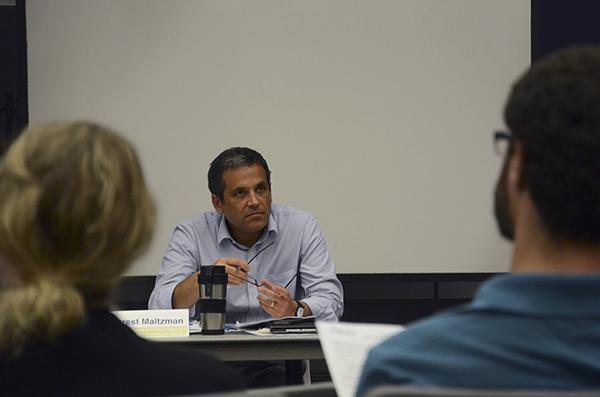The University’s top official wants more students to stick around.
University President Steven Knapp said in an interview last month that he will center this year around increasing the number of students who remain at and graduate from GW, a statistic known as a retention rate. And keeping students at GW will require more than making sure students can pay the bills, experts and officials said.
The retention rate has held steady at about 93 percent since 2011 and has not dropped to less than 89 percent in the last decade — meaning less than 11 percent of students have left the University each year for the past 10 years. Over the last eight years, each freshman class has lost roughly one-fifth of its original pool to transfers and dropouts after four years, according to GW’s Office of Institutional Research and Planning.
Knapp called GW’s retention rate, which is about 10 percentage points higher than the national average at four-year institutions, “an area of weakness.”
“The grimmest part of the current higher education picture in America is not just the number of students who don’t go to college, but the ones who go and don’t graduate,” he said.
Since arriving at GW in 2006, Knapp has prioritized affordability for students, from creating a task force centered on the topic last year. That group also proposed the test-optional admissions policy that officials adopted this summer. As colleges across the country struggle to keep diverse student bodies but rely heavily on tuition, some institutions are prioritizing changing retention policies as a way to keep students — and their dollars — on campus.
Since 2009, officials have raised more than $100 million for donor-funded Power and Promise scholarships, another way Knapp says GW can keep students on campus. The University also has a fixed-tuition policy, which keeps tuition at the same rate for five years for returning students.
Tuition has increased about 3 percent each year over the last five years. In May, the Board of Trustees signed off on a 6.5 percent increase in financial aid, bringing the total pool to $182 million for undergraduate students.
But Knapp said that when first-generation college students and their families delve into the college application and payment process, they may not know what to expect when it comes to finding out how much college can really cost. Students may also lack resources like “enough counselors in schools” to help guide them through the financial aid process.
Joni Finney, the director of the Institute for Research on Higher Education at the University of Pennsylvania, said that as colleges build financially diverse student bodies, officials will need to work harder to make sure low-income, first-generation or minority students graduate.
“If they just plop them in the traditional GW framework, there could be a real problem,” Finney said. “There’s a certain kind of intervention that could help students succeed, so you have to pay as much attention to that.”
Going beyond affordability
Knapp said in order to improve GW’s retention rates, officials will have to focus on “inner-community things” and creating a healthy campus where students want to stay — not just looking at ways to keep costs down.
Knapp said students may want to stay on campus if they feel supported by officials, and highlighted the importance of a “robust program of prevention and response” for sexual assault.
Former Graduate School of Education and Human Development professor Anna Uhl Chamot said in an email that the key to boosting retention is giving students opportunities to feel accomplished in the classroom.
“When teachers show students what they can do to be successful in their courses, they, the students, are likely to want to continue the experience of being a successful college student,” she said.
Senior Vice Provost for Academic Affairs and Planning Forrest Maltzman said in an email that it’s the responsibility of each faculty and staff member to focus on student retention.
“Every program, event and academic initiative that the University sponsors and hosts is designed to enhance the student experience both inside and outside of the classroom and as a result increase student retention,” Maltzman said.

Maltzman said retention initiatives at GW focus on both academic and social support because both of those factors are equally important in making sure students remain at the University.
“This could be an academic adviser who works with a student to identify tutoring resources, an RA that engages with a student in the residence halls to help them find their place at GW, a financial aid adviser who explores funding opportunities or a faculty member who enlists a student to work in a lab doing research,” he said.
Experts said increasing retention rates will also come from bolstering student experience. Officials increased student services spending by 40 percent between 2006 and 2012.
Robert Chernak, the former vice president for Student and Academic Support Services, spent 24 years at GW and helped to increase the financial aid pool while also establishing trademark student-life events like Colonial Inauguration and Colonials Weekend.
He said that enrolling and retaining a diverse freshman class with optimum potential for success is “like an airplane taking off.”
“If the seats are empty, the seats are empty. They’re not going to get filled mid-air,” he said. “Same thing with a freshmen class. If you have a high attrition, you can make some of it up with transfers, but you don’t fill all of those seats.”
Eva Palmer and Colleen Murphy contributed reporting.








